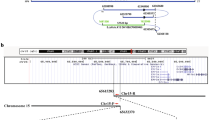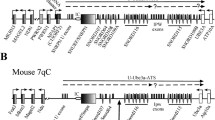Abstract
The SNRPN gene is known to be expressed exclusively from the paternal allele and to map to the critical region for the neurobehavioral disorder, Prader-Willi syndrome (PWS). As a means to investigate the mechanism of imprinting for the SNRPN gene, we have sought to recapitulate the imprinted expression of the endogenous gene. Using an 85-kb murine Snrpn clone, containing 33 kb of 5′ and 30 kb of 3′ flanking DNA, we obtained two intact transgenic lines. One line, containing two copies of the Snrpn transgene, recapitulated the imprinted expression pattern of the endogenous locus, whereas the other transgenic line, containing a single copy, was expressed upon both maternal and paternal inheritance. This suggests that a 6.6-kb region of maternal-specific DNA methylation that we have identified may be sufficient to confer imprinted expression, but not in a copy-number independent manner. Finally, we produced five lines of transgenic mice using a 76-kb human SNRPN clone containing 45 kb and 7 kb of 5′ and 3′ flanking DNA, respectively. We found all the lines were expressed upon both maternal and paternal inheritance, regardless of copy number, suggesting that the imprinting machinery in mouse and human may have diverged.
Similar content being viewed by others
Author information
Authors and Affiliations
Additional information
Received: 11 November 1998 / Accepted: 29 January 1999
Rights and permissions
About this article
Cite this article
Blaydes, S., Elmore, M., Yang, T. et al. Analysis of murine Snrpn and human SNRPN gene imprinting in transgenic mice. Mammalian Genome 10, 549–555 (1999). https://doi.org/10.1007/s003359901042
Published:
Issue Date:
DOI: https://doi.org/10.1007/s003359901042




